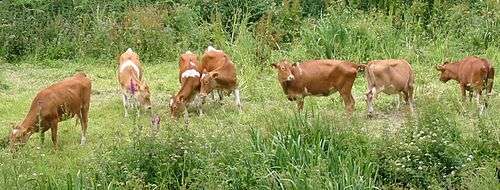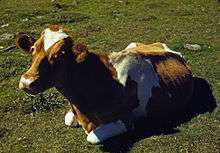Guernsey cattle

The Guernsey is a breed of cattle used in dairy farming. It is orange/red and white in colour, and is particularly renowned for the rich flavour of its milk, as well as its hardiness and docile disposition.
Milk
The milk has a golden colour due to a high content of beta carotene. Beta carotene is a source of vitamin A, which has been touted to help reduce the risks of certain cancers.[1] The milk also has a high butterfat content of 5% and a high protein content of 3.7%.[2] Guernsey cows produce around 6000 litres per cow per year.[3] In the US, Guernsey cows average 16,200 pounds of milk per year with 4.5% fat and 3.2% protein. Guernsey cattle are known to produce the highest percentage of A2 milk of all breeds of dairy cattle.
From the 1950s to the early 1970s, Golden Guernsey trademark milk was sold in the US and Canada as a premium product. The golden color produced by beta carotene bound to the fat in the milk was the main marketing point and the source of the brand name. Only milk from Guernsey cows could be marketed under the Golden Guernsey trademark. The advent of homogenisation and various changes to the way milk was priced and marketed spelled the end of Golden Guernsey branded milk.
Origin

As its name implies, the Guernsey was bred on the British Channel Island of Guernsey. It is believed to be descended from two breeds brought over from nearby France, Isigny cattle from Normandy and the Froment du Léon from Brittany.[4] The Guernsey was first recorded as a separate breed around 1700. In 1789, imports of foreign cattle into Guernsey were forbidden by law to maintain the purity of the breed, although some cattle evacuated from Alderney during World War II were merged into the breed.[5]
Exports of cattle and semen were for a while an important economic resource for the island, and in the early 20th century, a large number of Guernsey cattle were exported to the United States.[5] The Guernsey breed is on the watch list maintained by the American Livestock Breeds Conservancy, with fewer than 2,500 annual registrations in the U.S. and an estimated global population less than 10,000 animals.[6]
Characteristics
The cow weighs 450 to 500 kg, slightly more than the average weight of the Jersey cow which is around 450 kg (1000 pounds). The bull weighs 600 to 700 kg which is small by standards of domestic cattle, and they can be surprisingly aggressive. The Guernsey cow has many notable advantages for the dairy farmer over other breeds. These include high efficiency of milk production, low incidence of calving difficulty and longevity.[1] However, inbreeding is becoming a concern due to the small gene pool in a given area, and may be solved in most cases by exchanging cows with no overlap in lineage from other farms. They are orange and white in color.
See also
References
- 1 2 "Advantages of the Guernsey". WGCF (The World Guernsey Cattle Federation). 2006. Retrieved 2006-12-05.
- ↑ Anon (2004). "The Guernsey Cow - Background and History". Guernsey Cattle. Archived from the original on September 29, 2007. Retrieved 2006-12-05.
- ↑ "South African Guernsey Breeders". Studbook.co.za. Retrieved 2012-09-07.
- ↑ Luff, W. G. de L. (2004). "A Short History of The Guernsey Breed". WGCF (The World Guernsey Cattle Federation). Retrieved 2006-12-05.
- 1 2 Spahr, L. S.; Opperman, G. E. (1995). The Dairy Cow Today: U. S. Trends, Breeding & Progress Since 1980 (2nd ed. USA ed.). Hoard's Dairyman Books.
- ↑ "American Livestock Breeds Conservancy, Conservation Priority List, 2012"
External links
| Wikimedia Commons has media related to Guernsey cattle. |
- The American Guernsey Association
- English Guernsey Cattle Society
- The World Guernsey Cattle Federation
- Guernsey Cow Parade